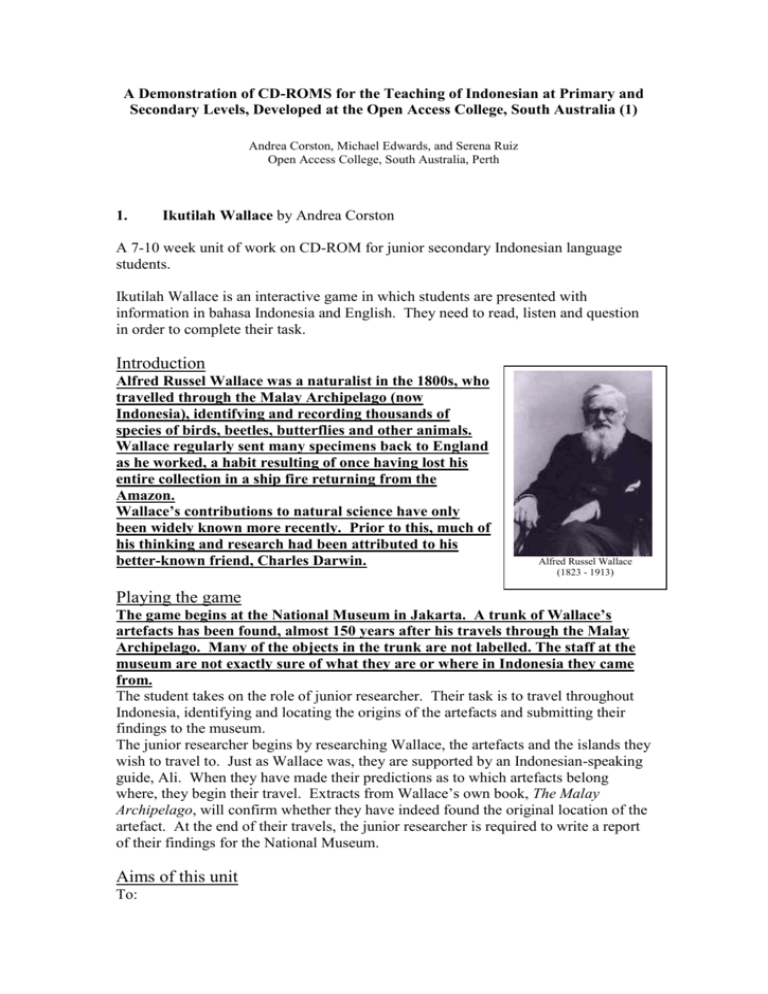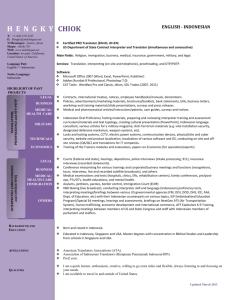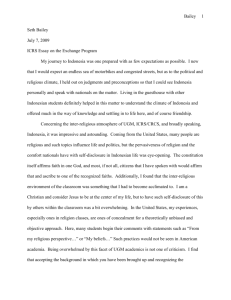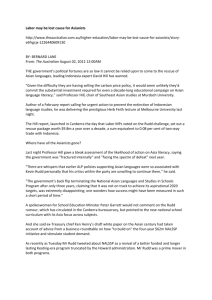AndreaCorston
advertisement

A Demonstration of CD-ROMS for the Teaching of Indonesian at Primary and Secondary Levels, Developed at the Open Access College, South Australia (1) Andrea Corston, Michael Edwards, and Serena Ruiz Open Access College, South Australia, Perth 1. Ikutilah Wallace by Andrea Corston A 7-10 week unit of work on CD-ROM for junior secondary Indonesian language students. Ikutilah Wallace is an interactive game in which students are presented with information in bahasa Indonesia and English. They need to read, listen and question in order to complete their task. Introduction Alfred Russel Wallace was a naturalist in the 1800s, who travelled through the Malay Archipelago (now Indonesia), identifying and recording thousands of species of birds, beetles, butterflies and other animals. Wallace regularly sent many specimens back to England as he worked, a habit resulting of once having lost his entire collection in a ship fire returning from the Amazon. Wallace’s contributions to natural science have only been widely known more recently. Prior to this, much of his thinking and research had been attributed to his better-known friend, Charles Darwin. Alfred Russel Wallace (1823 - 1913) Playing the game The game begins at the National Museum in Jakarta. A trunk of Wallace’s artefacts has been found, almost 150 years after his travels through the Malay Archipelago. Many of the objects in the trunk are not labelled. The staff at the museum are not exactly sure of what they are or where in Indonesia they came from. The student takes on the role of junior researcher. Their task is to travel throughout Indonesia, identifying and locating the origins of the artefacts and submitting their findings to the museum. The junior researcher begins by researching Wallace, the artefacts and the islands they wish to travel to. Just as Wallace was, they are supported by an Indonesian-speaking guide, Ali. When they have made their predictions as to which artefacts belong where, they begin their travel. Extracts from Wallace’s own book, The Malay Archipelago, will confirm whether they have indeed found the original location of the artefact. At the end of their travels, the junior researcher is required to write a report of their findings for the National Museum. Aims of this unit To: provide students with a source of information on Indonesian geography, wildlife and history in an innovative and interesting way give students the opportunity to develop and practise their use of bahasa Indonesia encourage students to make predictions, find clues, listen/read for overall meaning develop reporting skills develop technology skills. Communication outcomes Listening Students listen to, view and respond to a range of texts including video and audio clips. eg Students: view and listen to video clips of their native speaker guide, Ali, in order to extract information to help find the location of the original artefacts. Delayed subtitles in bahasa Indonesia provide language support. Clips can be played as many times as is necessary. listen to airport announcements for departure details. When correctly entered onto boarding passes the students progress to the next element of the game. This provides for purposeful and realistic language use. Speaking Students interact to exchange ideas, information and opinions. eg Students: participate in a simulated conversation with their native speaker guide, Ali. They enter responses onto the screen, and receive immediate feedback as to whether their response is appropriate or not. Students query, make arrangements and conclude the interaction. Reading Students read and respond to texts to interpret meaning and use the language in new contexts. eg Students: read a variety of texts including diary entries, descriptions, lists and forms in order to gather and cross-check information which provides clues as to the identity and original location of the artefacts. use various reading skills including scanning, reading for gist, or for specific detail to determine its relevance or irrelevance to the gathering of clues in the game. Writing Students write to convey personal experiences and opinions, and information about people, places and events. eg Students: take notes as they research and travel. In this way they gather information and organise their ideas for writing their own extended texts when completing the final assessment task. complete a final assessment task which is a report to the Museum Nasional. They reconstruct information from the various sources to give background information on their role and task and to recount their experiences. They express opinions on their experiences and reflect on their plans for the future. Understanding language outcomes Students recognise, practise and use language structures to help them complete their task. eg Students: use time expressions identify features on a map and give locations using terletak use terkenal untuk and terkenal sebagai to give information about specific islands make comparisons using dibandingkan dengan build more complex descriptions using yang express opinions identify patterns in language use use prediction to Students look for patterns across a range of texts (some simple, some more complex) to build knowledge of how the language works. eg Students: look for repetition of language structures in the texts on each island in order to build familiarity as they progress. Students use prediction and prior knowledge of the language to construct meaning in unfamiliar contexts. eg Students: complete cloze activities where the surrounding words provide clues as to the missing word or phrase. Understanding culture outcomes Students develop an understanding of the interdependence of language and culture. They develop an awareness of the history, biodiversity, geography and ethnicity of Indonesia. They reflect on changes to and influences on these aspects of Indonesian culture. Points for discussion 2. issues related to the use of multimedia resources in teaching of languages/bahasa Indonesia (teacher contact time, oral language use, access to hardware, compuer capabilities, teacher training) issues surrounding learning outcomes when developing multimedia resources (computer capabilities, text length, exploratory or linear navigation, CD-ROM or online) incorporating this unit of work into existing programs role of multimedia resources in distance education CD-ROM’s available through Open Access College for the teaching of Indonesian at the Primary level by Michael Edwards. Windows of the world. This is an instructional learning tool and is part of a broader Society and Environment program for children in year 1. This CD-ROM enables children to develop an understanding of the geography of the world an appreciation and tolerance of the diversity of cultures a sense of the wider world a knowledge of links between people and places Through supervised instruction of the CD-ROM children will have developed an expanded knowledge of the world a knowledge of experiences other than those of their immediate environment a heightened understanding of global issues skills that allow them to respond to questions and to record their responses Botanic Gardens A CD-ROM integrates the Indonesian language and studies at the Botanic Garden. It is a practical use of language in context as well as an introduction to the Botanic Garden. This CD-ROM enables students to learn some Indonesian language in context test themselves on their language knowledge Through supervised use the students can discover the names of tropical plants learn the attributes of these plants discover the traditional use of plants use the information as a lead towards further research Snapshots – Indonesia This is an image bank of approximately 100 photographs, separated into 10 categories. It is completely open ended, with no text and is an invaluable resource for students, supervisors and teachers of Indonesian and Asian studies. It allows students to access photos and to create their own text for use in reports or research work. Beginning Indonesian This series of CD-ROM are specifically designed for language instruction. The material is planned for students who have no experience or limited experience with Indonesian, and may not have access to a school or a trained language teacher. Many students have access to computers and the Internet and such course work is easily supplemented by the student/supervisor. The Beginning Indonesian course consists of three CD-ROM’s and two supervisor/teacher support booklets. The CD-ROM’s enable students to develop the skills to recognize and distinguish sounds understand and respond to routine courtesy exchanges respond to simple instructions and requests use simple words or phrases engage in reader like behaviour predict meaning using visual clues read familiar repetitive sections recognize and copy words illustrate understandings Students will learn and be able to follow instructions, make choices, self initiate and work independently. Students will further develop technical skills and be able to insert and eject a disk control the mouse understand icons and change screens using these icons use the space bar Discussion points. Introducing Indonesian in the early years of schooling. Promoting the teaching of and the use of resources for Indonesian in schools. Linking Indonesian studies to general classroom practice, through the use of Indonesian based materials for cross-cultural understanding projects without a language base. Using Snapshots. Indonesia in the classroom. Providing information on or about Indonesia to schools. Developing and implementing “Languages’ teaching in a range of schooling situations and educational contexts. Accessing information technology by remote and isolated students as well as availability in mainstream schools. 3. Jalan-jalan di Indonesia by Serena Ruiz A CD Rom/ Web CT unit designed for Year 9 students studying Indonesian through distance education at Open Access College, South Australia. Materials development The Year 9 Indonesian course consists of five print booklets and this CD Rom/ Web CT unit. In developing this unit, the level of understanding of bahasa Indonesia interests of Year 9 students was considered along with the needs of distance education students. All material now produced in South Australia is based on the South Australian Curriculum Standards and Accountability (SACSA) framework. Access to resources Many of the resources required are included in the CD Rom ‘Jalan-jalan’. Students view six destinations in Indonesia and read information about them. From this, students choose two destinations they wish to visit. There are also many links to the Internet throughout this unit, which students can use to find further information on the destinations they visit, To find out how to obtain a passport, what health measures need to be taken in order to travel in Indonesia, even what the current exchange rate is for the dollar and the rupiah. Communication tools such as a Bulletin board and Chat sessions are used for the teacher and students to discuss ideas and compare notes. Language learning outcomes Students work through many language activities, many of which are associated with travelling. They book an aeroplane ticket, choose and book a hotel, visit and note places of interest, send a postcard to a friend, buy souvenirs and even look at the concept of tourism and its impact in Bali. Some language activities are done on the computer screen using ‘click and drag’, and some are written in a journal and sent to the teacher. Students make choices about the places they visit and what they do there. There are a variety ogf texts, included some constructed and some authentic. There are oral activities and conversations in which the students are required to participate. Through the Bulletin Board and the Chat facility there is opportunity for students to brainstorm what they already know about a topic and to discuss the many open-ended questions which are presented to them in bahasa Indonesia and English. Incorporating multimedia resources into existing programs In distance education, the Internet is a great tool for research and most of our students have access to it. The use of communication tools such as Bulletin Board and Chat certainly add a lot to what would be discussion time in a face-to-face classroom.





